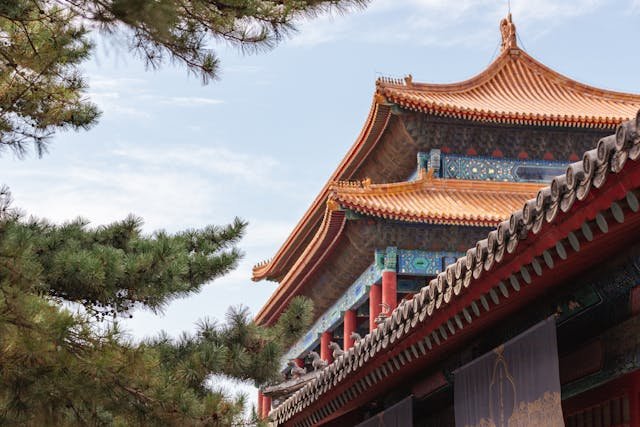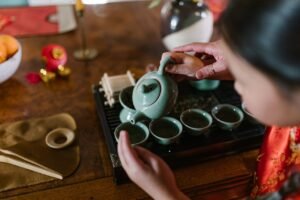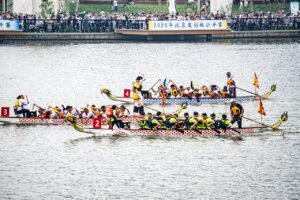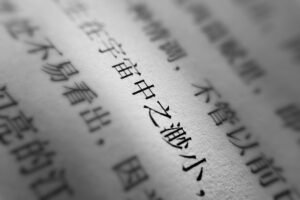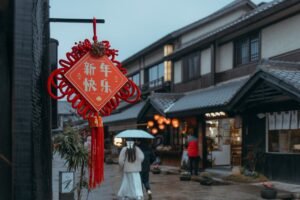Do you know about the hidden stories inside the world’s largest palace complex? It has 9,000 rooms and covers an area like 140 football fields. The secrets of China’s imperial palace go beyond its beautiful design and huge collections. They’re about the small details that make it a symbol of Chinese history and cultural heritage.
Emperor Yongle of the Ming Dynasty built the Forbidden City between 1406 and 1420. It shows the smart planning and skills of ancient Chinese people. Since 1925, the Palace Museum has kept over a million items. These items show off about a sixth of all of China’s historic pieces. From February 6, 2000, to September 3, 2000, a special exhibition displayed this rich history. It showed items like clothes, weapons, and a room where emperors had their thrones.
These exhibitions do more than just show the fancy things emperors had. They also show how thousands of artists made these items. When you visit the Forbidden City, you see how big it is. It covers 180 acres and has over 1,600,000 square feet of space. But more, you see the amazing skill and old customs it stands for. This Beijing attraction is really impressive.
Table of Contents
ToggleThe Origins and History of the Forbidden City
The Forbidden City is a huge symbol of China’s ancient history and grand architecture. It was started in 1406 by Emperor Yongle of the Ming dynasty. He chose Beijing for the new capital and built the city after becoming emperor through a hard fight with his nephew.
The Ming Dynasty and Emperor Yongle
Yongle moved the capital to Beijing to show his power and the grandeur of the empire. This was not just about politics. The move showed off the impressive new constructions that would be home to future emperors. The Forbidden City was designed to look powerful and blessed from above, especially in the Hall of Supreme Harmony.
The Move from Nanjing to Beijing
Yongle didn’t just move the capital; he started building a huge new palace. It was planned carefully to follow principles of feng shui and look in harmony with nature. Building the city was a massive project. They had to get materials from far away. By 1420, the Forbidden City was ready to be the main home for Chinese emperors.
Construction and Design of the Palace Complex
The city was built with care, stretching long and wide, covering large amounts of land. It was built to show the emperor’s power right across the city. Each building was arranged to symbolize how power was focused around the emperor’s rule. The Treatise on Architectural Methods gave instructions to make sure the city looked and felt grand.
The main gate and the biggest hall were made to amaze anyone who visited. They were huge, showing off the designers’ hard work. Everything was built to match the numbers nine and five, which shows the city’s important connection to Chinese beliefs about the universe.
For over 500 years, the Forbidden City was the home of Chinese emperors and their families. It was their center of rule and a place full of life. In 1912, after many years, its role as a place of governance changed. But it keeps on telling the story of China’s ancient past. Today, it’s a special place, protected by UNESCO, where people can learn about China’s rich history.
The Forbidden City as a UNESCO World Heritage Site
In 1987, UNESCO named the Forbidden City a World Heritage Site. This monumental decision highlights its immense impact on our history and culture. It is among the world’s biggest and most well-kept wooden structures, showcasing the magnificence of old Chinese culture.
Recognition and Preservation Efforts
UNESCO’s recognition marks the importance of protecting this ancient site. They ensure it won’t be lost to time or progress. The Forbidden City was valued at US$70 billion in 2018, making it the most valuable palace globally. A restoration project aimed to open 76% of the palace to the public by 2020, letting more people visit and experience its beauty.
Global Significance and Tourism
The Forbidden City attracts 14 million visitors yearly, a number that exceeded 19 million in 2019. This popularity shows the world’s strong interest in exploring its 8,886 unique rooms, spread across 72 hectares. It was China’s political and ceremonial center for over 500 years. Even today, over 80,000 people visit daily, making it the most visited museum in China. This underlines the continued appeal of UNESCO World Heritage Sites.
Secrets of China’s Imperial Palace Revealed
The Forbidden City is a wonder that shows off old symbols and smart building. It’s in Beijing, with over 9,000 rooms and 800 buildings. It’s as big as 140 football fields and was finished in 1420. It was a big step forward in both tech and art back then.
Mystical Symbolism and Architecture
The Forbidden City’s layout is deep. It shows special signs and ancient magical shapes. The Golden Water River looks like a bow, spreading protection power for the Emperor. With 9999.5 rooms, it shows how special the Emperor was believed to be.
The Forbidden City also used Dougong brackets a lot. They’re fancy wooden parts that show off the skills of the Ming times. They help the roof stay strong in quakes. This is key since the area often has quakes.
The Role of Feng Shui in the Layout
Feng shui made a big mark on the Forbidden City’s plan and look. It tries to bring nature and buildings together in a good way. The no trees in the outer area meant to show the Emperor’s high power.
The way the Golden Water River and bridges are set shows how much they thought about feng shui. It was to make the place safe and rich. Placing the river like they did keeps bad energy away, helping keep the peace where the Emperor lived.
| Aspect | Details |
|---|---|
| Rooms and Buildings | Over 9,000 rooms within 800 buildings |
| Construction Time | Major construction took four years, material preparation took 11 years |
| Orientation and Layout | South-north alignment based on feng shui principles |
| Earthquake Resilience | Utilized Dougong brackets for structural integrity |
| Symbolic Elements | Golden Water River’s protective design, 9999.5 rooms construction |
The Divine Layout: Axial Symmetry and South-North Orientation
The Forbidden City showcases ancient Chinese skills in imperial architecture and cosmic design. It spans a vast 178 acres, blending engineering with philosophy. Key to its design is its north-south axial symmetry.
Symbolism of the North Star (Polaris)
The city faces Polaris, the North Star, showing its link to Heaven. In Chinese belief, Polaris is where the Emperor of Heaven sits. This design shows the emperor’s divine role as a bridge between Heaven and Earth.
| Feature | Details |
|---|---|
| Area | 178 acres (72 hectares) |
| Age | 604 years old (as of 2024) |
| Major Events | Occupied by Anglo-French forces during the Second Opium War |
| Main Hall Dimensions | Hall of Supreme Harmony: 210 by 122 feet (64 by 37 meters) |
The Central Axis and Its Significance
The city’s central axis symbolizes the emperor’s place as the universe’s center. It spans from the grand Meridian Gate to the detailed Imperial Gardens. This design highlights the emperor’s supreme power on Earth and the heavens.
The Emperor’s Residence: Inner Court and Outer Court
The Forbidden City is huge, about 72 hectares. It’s split into the Inner Court and Outer Court. This shows where the Chinese emperors did their official work and lived privately. The design makes a clear line between what the public saw and what was kept for the emperor’s family.
Functions of the Outer Court
The Outer Court was the stage for big state events. It’s where the emperor would show off his power to people. Important celebrations like New Year and military parades happened here. The grand architecture set a perfect scene for these occasions.
The Private and Ceremonial Uses of the Inner Court
In contrast, the Inner Court was for the emperor’s private life. It was his place to get away from the public. Here, he and his family had their private rituals and daily life moments.
This part of the palace was carefully designed. It aimed to show the emperor as a divine ruler. It stands as a symbol of China’s rich history with over 600 years worth of stories.
| Aspect | Outer Court | Inner Court |
|---|---|---|
| Function | Public Ceremonies | Private and Family Life |
| Main Activities | Proclamation of Edicts, State Ceremonies | Daily Activities, Private Rituals |
| Access | Limited access for high-ranking officials and visitors | Restricted to the Imperial Family and select servants |
Inside the Forbidden City: Secrets of China’s Imperial Palace
The Forbidden City is a huge complex filled with secrets of China’s ancient rulers. It was built in just four years, has over 9,000 rooms, and covers 140 football fields. With at least 800 buildings, this vast palace complex was designed to impress.
Despite earthquakes being common in the area, the Forbidden City has never fallen. Thanks to smart design, the dougong brackets have kept it safe for thousands of years. Even a big earthquake in 1976 couldn’t destroy it.
Legend says the city was laid out precisely with almost 10,000 rooms, very close to perfection. Its design shows the emperor’s thought to be as important as heaven. Building it took 11 years of preparation, like moving a huge rock with 20,000 people’s help.
| Aspect | Detail |
|---|---|
| Number of Rooms | 9,000+ |
| Total Area | 140 football fields |
| Construction Time | 4 years |
| Resilience | Withstands earthquakes |
| Architectural Features | Dougong brackets |
| Material Preparation | 11 years |
| Rock Transportation | 20,000 people, 28 days |
The Forbidden City was carefully designed with symbols important for the emperor’s power and protection. It’s all part of the grand plan to keep the ruler revered. The absence of trees in the outer court and special structures like the Golden Water Bridge enhanced its mystique.
Building this city took a lot of work and heart. It’s been a UNESCO World Heritage Site since 1987. Today, it still captures the imagination of millions every year with its grand halls and stories of the past.
The Role of the Hall of Supreme Harmony
The Hall of Supreme Harmony is vital in Chinese history and is a key part of the Forbidden City. It’s a grand building that shows the emperor’s role in power and big ceremonies.
Key Ceremonial Functions
For many years, the Hall of Supreme Harmony was a place for important events. It saw things like the crowning of emperors, wins in battles by the empire, and the great celebrations of the emperor’s birthday.
Measuring at 210 by 122 feet (64 by 37 meters), this hall showed the importance of these events. It is one of China’s biggest wooden buildings, showing off the best of the empire’s power.
The Emperor’s Dragon Throne
In the Hall of Supreme Harmony, the Emperor’s Dragon Throne stands at the center. It’s a strong symbol of the emperor’s power and right to rule. The throne is not just a seat; it’s a work of art. It shows the emperor’s control over the country and even the world, according to ancient beliefs.
The design is detailed and uses luxury materials, reflecting the emperor’s wealth and strength. This makes the Forbidden City, with its impressive throne, a sign of China’s great history.
The table below provides some contextual data on the Hall of Supreme Harmony:
| Feature | Details |
|---|---|
| Total Area of the Forbidden City | 72 hectares (178 acres) |
| Total Floor Space | 150,000 square meters (1,600,000 square feet) |
| Age of the Forbidden City (as of 2024) | 604 years |
| Height of the Wu Gate | 125 feet (38 meters) |
| Width and Length of Hall of Supreme Harmony | 210 by 122 feet (64 by 37 meters) |
Importance of the Meridian Gate
The Meridian Gate marks the main entrance to the Forbidden City. It’s essential in Chinese history and famous for its detailed imperial architecture. The gate lets people into the Forbidden City, showing the Emperor’s powerful role.
Gate Design and Symbolic Meanings
The Meridian Gate is known for its five gateways, with the center only for the Emperor. This design shows harmony and reflects the view of world order in Chinese history. Its large size and where it’s placed show its huge importance as a symbol of the Emperor’s power.
Milestones and Ceremonies
For centuries, the Meridian Gate has been a key setting for important events. It was where the Emperor spoke to his army before battles and shared the new lunar calendar. Also, it was a key place for big activities like welcoming war prisoners and making important national announcements.
| Event | Description |
|---|---|
| Addressing the Army | The Emperor would traditionally address his army before embarking on a campaign, making the gate a symbol of military might. |
| Lunar Calendar Announcement | The new lunar calendar was proclaimed by the Emperor from the Meridian Gate, underscoring the cosmological significance of the gate in Chinese history. |
| State Proclamations | Significant imperial edicts and proclamations were often declared at the Meridian Gate, reinforcing the central role of the gate in the imperial architecture. |
To sum up, the Meridian Gate is a lasting symbol of the Forbidden City’s majesty. It connects the past to imperial architecture through its design and the major events it was part of.
The Influence of Imperial Dynasties on Forbidden City Architecture
The Forbidden City shows the rich history of China’s emperors through its design. This huge site is as big as 140 football fields. It has over 800 buildings and was mainly built in just four years.
“Ming Dynasty China had not only a dominant economy but also technological superiority over the West. This was evident in the construction and resilience of the Forbidden City.”
During the Ming Dynasty, the Emperor Yongle started building it in 1406. It was finished by 1420. About a million workers helped, making it a key part of China’s past. Its architecture survived a big earthquake in 1976 thanks to special wooden supports.
The Qing Dynasty then added to the Forbidden City’s beauty. They lived lavishly, with roughly 20,000 women in the emperor’s harem. Each dynasty added their style and made changes as needed. This makes the city’s architecture unique and telling of China’s imperial evolution.
The Forbidden City has always been a symbol of China’s ancient power. It has been well taken care of over the years. The efforts keep the city open for people to visit. Today, it remains one of China’s top sites, showing its fascinating past to the world.
| Aspect | Ming Dynasty | Qing Dynasty |
|---|---|---|
| Duration of Construction | 14 years (1406-1420) | Continuous modifications and additions |
| Architectural Influence | Rapid completion, technological advancement | Opulence, restoration, and preservation |
| Significant Features | Wooden dougong brackets, resilience against earthquakes | Increased rooms, luxurious quarters for the harem |
| Current Visitor Statistics | Beyond initial construction | Over 19 million in 2019 |
The Forbidden City is a huge sign of China’s past emperors’ rule. Its mix of old and new styles continues to impress people worldwide. It’s a must-see for anyone interested in history and architecture.
The Architectural Genius of Kuai Xiang
The Forbidden City is a model of Kuai Xiang’s architectural excellence. His idea shaped this palace, blending Chinese history and celestial meanings. It stands as a grand part of Chinese culture.
Philosophy and Design Principles
Kuai Xiang used deep philosophies to craft the Forbidden City. His design emphasized the emperor’s supreme rule. It featured perfect symmetry, highlighting the emperor’s might.
The Hall of Supreme Harmony connected the emperor to the skies.
The Challenges and Triumphs of Construction
Building the Forbidden City posed many hurdles. More than a million workers collaborated, from which over 100,000 were craftsmen. They managed to finish 980 buildings in a 180-acre area.
They moved massive rocks and located rare woods far and wide, showcasing China’s engineering skills. This was during the Ming Dynasty’s rule.
| Aspect | Details |
|---|---|
| Total Workers | 1,000,000+ |
| Craftsmen | 100,000+ |
| Buildings | 980 |
| Total Area | 72 hectares (180 acres) |
Kuai Xiang’s success birthed a grand palace, the imperial center for over 492 years. His brilliance and hard work left an indelible mark on China’s history. His creation showcases Chinese architecture at its peak.
Even today, the Forbidden City charms countless visitors. It stands as a lasting symbol of its architect’s unparalleled talent and China’s rich history. It is a testament to resilience, creativity, and historical value.
Exploring the Forbidden City Museums
The Palace Museum is found in the Forbidden City’s center. It’s a huge collection of history and culture. Over one million rare works make it a must-see for history and art fans.
Main Museum Collections
Step into Chinese imperial history through the museum’s varied collections. See ceramics, paintings, and more. Each item shares its era’s story and cultural value. You’ll also find manuscripts and imperial seals, offering a peek into the dynasty world.
Special Exhibitions and Artifacts
The Palace Museum has changing exhibitions that share new history insights. These shows highlight ancient Chinese creativity. They cover topics like dynastic rituals and show creatures protecting the Palace. These events draw many visitors, making them key to exploring Beijing.
| Key Facts | Details |
|---|---|
| Total Floor Space | 150,000 sq m (1,600,000 sq ft) |
| Artifacts | Over a million rare and valuable works of art |
| Daily Visitor Limit | 80,000 |
| Main Colors | Yellow and Red |
| Anniversary | 600th in 2021 |
The Forbidden City is a key part of preserving China’s cultural legacy. It offers a deep link to China’s ancient times. Through its collections and events, the Palace Museum creates amazing and memorable visits.
The Role of Eunuchs and Concubines in the Forbidden City
In olden China, the Forbidden City was the heart of both political might and personal realms. Here, eunuchs and concubines held key positions in the imperial court’s tight-knit system. They filled their days with important duties, often mingled with power plays and secrets. This mix helped shape China’s past in ways that are still felt today.
Daily Lives and Responsibilities
Eunuchs did a bit of everything in the Forbidden City. From simple chores to crucial palace roles, they were found at the center. Kings as far back as the eighth century BC used castrated men to guard harem purity. By the Qing dynasty, eunuchs oversaw selecting the emperor’s female attendants. They were actually key players, safeguarding the ladies’ morals, while acting as the emperor’s eyes and ears.
Concubines, though, sought the emperor’s approval above all else. To become a concubine was no easy feat, involving tests of looks, smarts, and virtue. Once in, the women competed in a strict ranking, influencing their family’s status by their closeness to the emperor.
Power and Influence in the Imperial Court
Eunuchs were not to be underestimated in the power game. Initially seen as safe from power grabs due to their lack of offspring, they often led young kings. They shaped emperors’ characters and the way they ruled. This could cause friction among China’s elite, sparking power fights.
Concubines fought for the emperor’s eyes and ears, as his favor could change their family’s fortune. They worked within a system where the top wife ruled over the others. The political maneuvering within this system had deep effects within the Forbidden City’s walls.
| Role | Responsibilities | Influence |
|---|---|---|
| Eunuchs | Guarding harems, selecting concubines, performing menial tasks, acting as spies, managing palace activities | Manipulating young rulers, influencing governance, vying for power amidst court politics |
| Concubines | Gaining the emperor’s favor, participating in ceremonial duties, enhancing family standing | Improving familial status, navigating hierarchical structures, influencing palace intrigues |
These roles in the Forbidden City show how eunuchs and concubines were central in ancient China. By seeking power through their daily work, they changed the course of China’s history and its power play.
The Symbolic Elements of Imperial Architecture
The Forbidden City’s grandeur is vast and deep, showing not just size but also symbolic beauty. Colors and materials are key, reflecting the emperor’s divine power. They show a rich mix of cultural and mystical messages.
The Use of Colors and Materials
In the Forbidden City, colors and materials are more than just decorations. Red stands for joy and luck, while yellow stands for the emperor’s power. Other buildings have blue or black roofs, with black symbolizing water energy. This detailed use of colors covers the city’s 72 hectares, adding to its mystical story.
Animal Statuettes and Their Meanings
The city is not just about colors. It’s adorned with statues of dragons, phoenixes, and lions. These animals stand for imperial power, good luck, and protection. The statues highlight the significance and deep symbolism in the city’s design.
The city’s design also follows Feng Shui, connecting with the earth’s energy. This careful layout makes the Forbidden City a wonder not only of architecture but also of deep meaning from ancient times.
Source Links
- https://www.chinahighlights.com/beijing/forbidden-city/
- https://www.pbs.org/video/secrets-of-the-forbidden-city-1o8igy/
- http://www.beijingwalking.com/forbidden-city-facts/
- https://www.britannica.com/topic/Forbidden-City
- https://smarthistory.org/the-forbidden-city/
- https://en.wikipedia.org/wiki/Forbidden_City
- https://whc.unesco.org/en/list/881/
- https://www.ancient-origins.net/ancient-places-asia/great-forbidden-city-glimpse-chinas-imperial-past-001808
- https://www.academia.edu/34017227/Ming_China_Courts_and_Contacts_1400_1450
- https://bigobooking.com/china/beijing/attraction/forbidden-city-china.html
- https://elischolar.library.yale.edu/cgi/viewcontent.cgi?article=1004&context=envdesign
- https://artsandculture.google.com/project/treasures-of-the-palace-museum
- https://www.usrf.org/news/010308-hiddenpower.html
- https://multimedia.scmp.com/culture/article/2154046/forbidden-city/life/chapter_01.html
- https://multimedia.scmp.com/culture/article/2155959/forbidden-city/life/chapter_02.html
- https://www.fengshui.net/travel/secrets-of-the-forbidden-city-5774/
- https://oritreasure.com/blogs/oriental-palace/forbidden-city-unveiled-a-journey-through-centuries-of-secrets-in-chinas-imperial-palace

